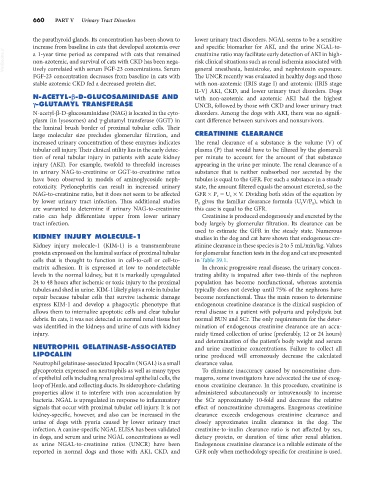Page 688 - Small Animal Internal Medicine, 6th Edition
P. 688
660 PART V Urinary Tract Disorders
the parathyroid glands. Its concentration has been shown to lower urinary tract disorders. NGAL seems to be a sensitive
increase from baseline in cats that developed azotemia over and specific biomarker for AKI, and the urine NGAL-to-
VetBooks.ir a 1-year time period as compared with cats that remained creatinine ratio may facilitate early detection of AKI in high-
risk clinical situations such as renal ischemia associated with
non-azotemic, and survival of cats with CKD has been nega-
tively correlated with serum FGF-23 concentrations. Serum
The UNCR recently was evaluated in healthy dogs and those
FGF-23 concentration decreases from baseline in cats with general anesthesia, heatstroke, and nephrotoxin exposure.
stable azotemic CKD fed a decreased protein diet. with non-azotemic (IRIS stage I) and azotemic (IRIS stage
II-V) AKI, CKD, and lower urinary tract disorders. Dogs
N-ACETYL-β-D-GLUCOSAMINIDASE AND with non-azotemic and azotemic AKI had the highest
γ-GLUTAMYL TRANSFERASE UNCR, followed by those with CKD and lower urinary tract
N-acetyl-β-D-glucosaminidase (NAG) is located in the cyto- disorders. Among the dogs with AKI, there was no signifi-
plasm (in lysosomes) and γ-glutamyl transferase (GGT) in cant difference between survivors and nonsurvivors.
the luminal brush border of proximal tubular cells. Their
large molecular size precludes glomerular filtration, and CREATININE CLEARANCE
increased urinary concentration of these enzymes indicates The renal clearance of a substance is the volume (V) of
tubular cell injury. Their clinical utility lies in the early detec- plasma (P) that would have to be filtered by the glomeruli
tion of renal tubular injury in patients with acute kidney per minute to account for the amount of that substance
injury (AKI). For example, twofold to threefold increases appearing in the urine per minute. The renal clearance of a
in urinary NAG-to-creatinine or GGT-to-creatinine ratios substance that is neither reabsorbed nor secreted by the
have been observed in models of aminoglycoside neph- tubules is equal to the GFR. For such a substance in a steady
rotoxicity. Pyelonephritis can result in increased urinary state, the amount filtered equals the amount excreted, so the
NAG-to-creatinine ratio, but it does not seem to be affected GFR × P x = U x × V. Dividing both sides of the equation by
by lower urinary tract infection. Thus additional studies P x gives the familiar clearance formula (U x V/P x ), which in
are warranted to determine if urinary NAG-to-creatinine this case is equal to the GFR.
ratio can help differentiate upper from lower urinary Creatinine is produced endogenously and excreted by the
tract infection. body largely by glomerular filtration. Its clearance can be
used to estimate the GFR in the steady state. Numerous
KIDNEY INJURY MOLECULE-1 studies in the dog and cat have shown that endogenous cre-
Kidney injury molecule-1 (KIM-1) is a transmembrane atinine clearance in these species is 2 to 5 mL/min/kg. Values
protein expressed on the luminal surface of proximal tubular for glomerular function tests in the dog and cat are presented
cells that is thought to function in cell-to-cell or cell-to- in Table 39.1.
matrix adhesion. It is expressed at low to nondetectable In chronic progressive renal disease, the urinary concen-
levels in the normal kidney, but it is markedly upregulated trating ability is impaired after two-thirds of the nephron
24 to 48 hours after ischemic or toxic injury to the proximal population has become nonfunctional, whereas azotemia
tubules and shed in urine. KIM-1 likely plays a role in tubular typically does not develop until 75% of the nephrons have
repair because tubular cells that survive ischemic damage become nonfunctional. Thus the main reason to determine
express KIM-1 and develop a phagocytic phenotype that endogenous creatinine clearance is the clinical suspicion of
allows them to internalize apoptotic cells and clear tubular renal disease in a patient with polyuria and polydipsia but
debris. In cats, it was not detected in normal renal tissue but normal BUN and SCr. The only requirements for the deter-
was identified in the kidneys and urine of cats with kidney mination of endogenous creatinine clearance are an accu-
injury. rately timed collection of urine (preferably, 12 or 24 hours)
and determination of the patient’s body weight and serum
NEUTROPHIL GELATINASE-ASSOCIATED and urine creatinine concentrations. Failure to collect all
LIPOCALIN urine produced will erroneously decrease the calculated
Neutrophil gelatinase-associated lipocalin (NGAL) is a small clearance value.
glycoprotein expressed on neutrophils as well as many types To eliminate inaccuracy caused by noncreatinine chro-
of epithelial cells including renal proximal epithelial cells, the magens, some investigators have advocated the use of exog-
loop of Henle, and collecting ducts. Its siderophore-chelating enous creatinine clearance. In this procedure, creatinine is
properties allow it to interfere with iron accumulation by administered subcutaneously or intravenously to increase
bacteria. NGAL is upregulated in response to inflammatory the SCr approximately 10-fold and decrease the relative
signals that occur with proximal tubular cell injury. It is not effect of noncreatinine chromagens. Exogenous creatinine
kidney-specific, however, and also can be increased in the clearance exceeds endogenous creatinine clearance and
urine of dogs with pyuria caused by lower urinary tract closely approximates inulin clearance in the dog. The
infection. A canine-specific NGAL ELISA has been validated creatinine-to-inulin clearance ratio is not affected by sex,
in dogs, and serum and urine NGAL concentrations as well dietary protein, or duration of time after renal ablation.
as urine NGAL-to-creatinine ratios (UNCR) have been Endogenous creatinine clearance is a reliable estimate of the
reported in normal dogs and those with AKI, CKD, and GFR only when methodology specific for creatinine is used.

